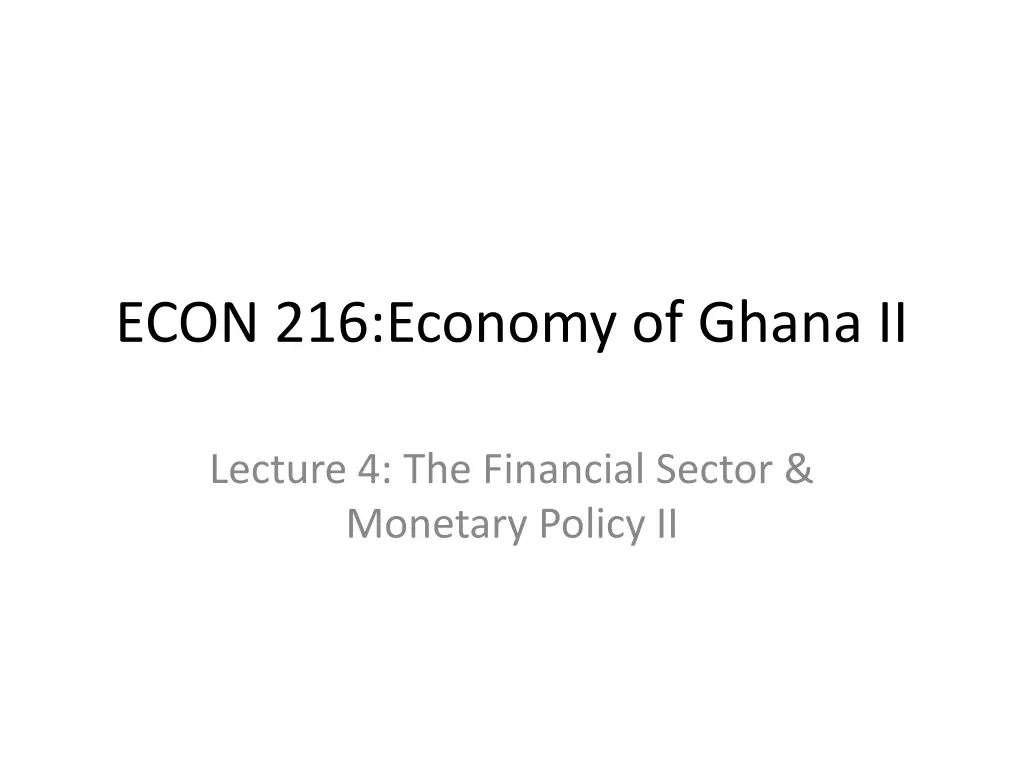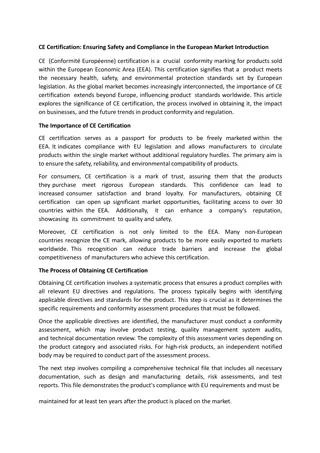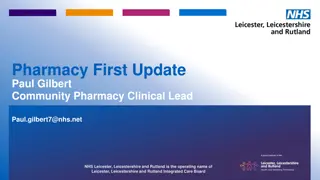
Banking Activities in Ghana: Commercial & Rural Banks
Explore the functions of commercial banks in Ghana as defined by the Banking Act, 2002, including lending, investment, and money transmission services. Learn about rural banking introduced by the government in 1976, focusing on community development and financial inclusion. Discover how rural banks mobilize funds, provide credit facilities, and engage in corporate social responsibility initiatives.
Download Presentation

Please find below an Image/Link to download the presentation.
The content on the website is provided AS IS for your information and personal use only. It may not be sold, licensed, or shared on other websites without obtaining consent from the author. If you encounter any issues during the download, it is possible that the publisher has removed the file from their server.
You are allowed to download the files provided on this website for personal or commercial use, subject to the condition that they are used lawfully. All files are the property of their respective owners.
The content on the website is provided AS IS for your information and personal use only. It may not be sold, licensed, or shared on other websites without obtaining consent from the author.
E N D
Presentation Transcript
ECON 216:Economy of Ghana II Lecture 4: The Financial Sector & Monetary Policy II
Functions of Commercial Banks The Banking Act, 2002 (ACT 673) lists the following as the Permissible Activities of Banks ; acceptance of deposits and other repayable funds from the public: lending; financial leasing; investment in financial securities: money transmission services; issuing and administering means of payment including credit cards, travellers cheques and bankers drafts;
Functions of Commercial Banks guarantees and commitments; trading for own account or for account of customers in,(i) money market, (ii) instruments, (iii) foreign exchange, (iv) transferable securities; participation in securities issues and provision of services related to those issues; advice to undertakings on capital structure, acquisition and merger of undertaking; portfolio management and advice; the keeping and administration of securities; credit reference services; safe custody of valuables; electronic banking; and any other services as the Bank of Ghana may determine.
Rural Banking in Ghana The government of Ghana through the Central Bank introduced rural banking in 1976 . The first established was the Agona Nyakrom Rural Bank in a farming community in the Central Region. Rural banks are fully owned by individual shareholders who tend to be residents of the community within which they operate. The essence of rural/ community banking was to bring the rural population into the banking system to ensure growth in an economy that is largely agrarian. The believe also is that there is the need to mobilise resources are locked up the rural economy, while providing support for viable industry within the respective communities. These banks operate taking into consideration the occupation of the rural folk.
Rural Banking in Ghana Rural banks usually undertake a mix of micro-finance and commercial banking activities within their communities; they mobilise funds in the form of savings/current accounts, susu deposits and fixed/time deposits, and provide credit facilities different categories of people, including salaried workers, cottage industry and traders. These banks are involved in providing credit for the payment of school fees, meeting medical expenses, purchasing of land/ houses, etc. Rural banks also undertake a number of CSR by channelling part of their profits intervention programs in health, education, the vulnerable in the their areas and supporting the traditional authority. Others have gender-based programs that focus on providing support for women involved in small business.
Rural Banking in Ghana Prior to their establishment in Ghana, access to credit for farm and non-farm activities in rural communities were limited to money lenders and traders who charged usurious interest rates. Many rural folk had to travel long distances to receive salaries, pensions and cash checks for agricultural produce since there was no safe, secure, and convenient financial facilities. Government in an attempt to resolve some of these set up the ADB in 1965 with a mandate to extend credit to agriculture and allied industries. Branches of ADB and other commercial banks were later opened in rural areas, but were concentrated in cocoa-growing areas. More so, they demanded higher deposit accounts and stronger collateral requirements, which many rural folk could not meet. Government therefore supported the establishment of rural/ community banks that will be committed to providing financial services in these areas.
Rural Banking in Ghana By 1980, rural /community banks numbering 20 formed the Association of Rural Banks (ARB), which promoted and represented the Banks, as well as provided training services to members. Their numbers continued to grow sturdily. By 1983, the performance of the rural / community banks declined for a number of reasons, including the drought that hit the agricultural sector leading to many loan defaults, internal managerial conflicts, inefficiencies, and weak regulation. Following the implementation of financial reforms in the 1980s, in recognition of the importance of these institutions, rural and community banks were allowed to operate, but under rules designed to suit their socio- economic circumstances.
Rural Banking in Ghana Despite the reforms, Rural/ Community banks have not always performed well; in 1998, the BoG liquidated 23 rural banks. In a 2008 International Fund for Agricultural Development (IFAD) report, the BoG described 17 of the 127 rural banks at the time as mediocre (6 of which had negative net worth) based on capital adequacy, and categorised 5 banks as mediocre. The ARB Apex Bank was granted a banking license in 2001 and commenced commercial operations in 2002 with significant financial support from the Rural Financial Service Project, which was funded by the World Bank, the International Fund for Agricultural Development, and the African Development Bank.
Rural Banking in Ghana The Apex Bank provides specialized services essential to improving the quality and scope of products offered by RCBs and also performs important supervisory functions delegated by the BoG. Check clearing, treasury management, loan fund mobilization, domestic and international money transfers, information and communication technology, training, and inspection and audit are among the main services offered by the Apex Bank. The Apex Bank provides most of the services on a fee basis.
Rural Banking in Ghana See the following for more information about the ARB Apex Bank: www.arbapexbank.com/aboutus.php www.arbapexbank.com/function.php See the list of registered Rural & Community Banks from the BoG as at March 2012; http://www.bog.gov.gh/index.php?option=co m_content&view=article&id=83:rural-and- community-banks&catid=72&Itemid=125
Non-Bank Financial Institutions in Ghana These formerly operated under the Non-Banking Financial Institutions (NBFIs) Act in 1993 (P.N.D.C. Law 328). The new Non-bank Financial Institutions Act, 2008 (Act 774) and the Banking Act, 2004 (Act 673) as amended by Act 738 has changed the structure of Ghana s financial sector with regard to NBFIs. Categorization under the Non-bank Financial Institutions Act 2008 has increased from a single tier to four tiers, to include susu companies, susu collectors, money lenders and financial NGOs.
Non-Bank Financial Institutions in Ghana Credit unions fall under the second tier, but the Bank of Ghana is yet to pass a Legislative Instrument to regulate activities in the sector. The third tier of money lenders and non-deposit taking financial Activities under the fourth tier include the operations of individual susu collectors, susu enterprises, individual money lenders and money lending enterprises. Operators under this tier belong to an umbrella body like the Ghana Cooperative Susu Collectors Association (GCSCA).
Non-Bank Financial Institutions in Ghana Meanwhile, regulation under the first tier, including rural and community banks, savings and loans companies and other financial intermediaries already regulated under the Banking Act, remains unchanged. NBFIs in Ghana now include (53); Finance Houses Leasing Finance and Leasing Mortgage Finance Companies Savings and Loans Companies Credit Reference Bureau - 25 - 2 - 3 - 1 - 19 - 3
Non-Bank Financial Institutions in Ghana NB the following NBFIs; Credit Unions ( an interesting history of credit unions in Ghana) http://www.cuagh.com/cua/about-us/history http://www.cuagh.com/cua/about-us/cuas-role-in- ghana The Credit Union Association (CUA) serves as a self- regulatory apex body for the credit unions. CUA applies prudential norms that are similar to the operating and financial standards of the World Council of Credit Unions (WOCCU). BOG has desisted from extending its regulatory activities to Credit Unions.
Non-Bank Financial Institutions in Ghana Forex bureaux Insurance Companies SEC & GSE Q: What are the functions of the different NBFIs?
Monetary Policy in Ghana Outline What monetary policy Objectives of monetary policy Instruments of Monetary Policy Inflation Targeting in Ghana (A second look)
What is monetary policy MP the management of money ss and interest rates in order to achieve the objectives of stability and growth of an economy. To maintain output near full employment whilst ensuring price stability using various tools such as OMO, reserve requirements, discount rate, moral suasion, prime rate, etc. Expansionary Monetary Policy where there is an increase in money ss, lowering of policy rate to increase output and employment esp. during recessions Contractionary Monetary Policy reduction in money ss, increase in policy rate to bring about stability in general price level. The stance of monetary policy could be accommodative, neutral or tight, depending on the general economic conditions prevalent in a nation.
Objectives/ Goals of Monetary Policy Price Stability Economic Growth High Employment Balance of payments and exchange rate stabilization Maintaining stability of financial markets
Tools of Monetary Policy in Ghana Direct tools of monetary policy One-to-one correspondence between the instrument and policy objective Selective credit controls; determining the amount and direction of credit to perceived critical sectors of the economy. Achieved via credit ceilings and lending directives. For instance, in Ghana between 1970 1982, commercial banks were directed by BoG to channel 20-30% of loans to agriculture sector. Following reforms in the financial sector which begun during the late 1980s, direct tools of monetary policy were abandoned.
Tools of Monetary Policy in Ghana Following the liberalisation of the financial sector Indirect/ market based tools of monetary policy were adopted; Open Market Operations; the sale and purchase of government securities by the central bank as a means of indirectly influencing the general price level / growth in the economy. Sale/purchase is to commercial banks, insurance companies, business houses and individuals. Instruments include treasury bills, central bank bills, or prime commercial paper.
Tools of Monetary Policy in Ghana Repurchase Agreements/ REPOS; The Central bank purchases government securities from commercial banks with an agreement that the seller will repurchase them in a short period of time, usually from overnight to 14 days. Effects on bank reserves are reversed on day agreement matures, thus acting like temporary market purchase. Reserve requirements; Proportion of deposits commercial banks are required by law to keep as reserves with Central Bank. This attracts no interest. Its effect tend to be immediate. Bank Rate/ discount rate/ Prime rate; minimum lending rate of Central bank at which it rediscounts first class bills of exchange and government securities held by commercial banks. An increase in this rate increases the cost of borrowing.
Tools of Monetary Policy The Bank rate has in Ghana been replaced by a policy variable called the Prime rate (overnight funds rate). It gives the market an indication of the monetary policy stance of the Central bank, and thus is expected to influence the behaviour economic agents. Question: How are these indirect tools used by the Bank of Ghana to achieve the objectives of price stability and economic growth in an economy (or during periods of high inflation and periods of recession)?
Inflation Targeting and Monetary Policy Committee A monetary policy framework within which policy decisions and actions are guided by the expected path of future inflation relative to an announced inflation target. In Ghana, this is done through periodic adjustments to the prime rate. The review may be done on a monthly or quarterly basis by the Monetary Policy Committee. These adjustments are made based on market indicators and surveys, in an attempt to forecast economic trends. All efforts are directed at keeping inflation within the desired range of single digit.
Inflation Targeting and Monetary Policy Committee In order to track the underlying inflation, the BoG uses core CPI which excludes energy and utility prices (the GSS usually reports the headline CPI). A critical element to the process has to do with transparency; economic reports, press conferences after MPC meetings, publication of inflation reports. Increased communication with the public about the monetary plicy decision making process keeps the public well informed and anchors their expectation Due to increased transparency, the framework improves the accountability of the Central Bank. The framework was first used in New Zealand. Ghana and South Africa are the only two African countries to have adopted the policy framework.
The Monetary Policy Committee The Bank of Ghana 2002 (Act 612) established the Monetary Policy Committee. This was in recognition of the need for clarity, transparency and specificity in communicating with the public on policy, which has become recognised as crucial globally. Transparency promotes credibility, as information supplied to the public helps to shape expectations. The 7 member Policy Committee is responsible for initiating monetary policy. It meets every other month (or six times a year), for a period of three days; the first two are spent analysing a wide range of indicators and conditional forecasts of inflation. The decision on the policy rate is taken on the third day by consensus.

















